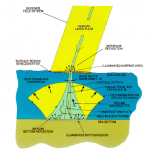Greetings,
I would like to monitor the ground-to-water-surface-level vertical separation distance in a well using a TOF 850nM laser range sensor. The water is visibly very clear and has some mineral content. The beam would be perpendicular to the plane of the water surface. I have three questions:
1) I wonder if the clear water will reflect the sensor beam sufficiently to permit successful measurement of the water level when the distance approaches the the maximum range of the sensor?
2) I wonder what percentage of the incident beam would be reflected by the visibly clear water?
3) I noticed infrared range sensors with wavelengths that vary from 600-900nM. I wonder what the best wavelength would be for this application?
Thanks in advance for any helpful comments and/or suggestions.
tma
I would like to monitor the ground-to-water-surface-level vertical separation distance in a well using a TOF 850nM laser range sensor. The water is visibly very clear and has some mineral content. The beam would be perpendicular to the plane of the water surface. I have three questions:
1) I wonder if the clear water will reflect the sensor beam sufficiently to permit successful measurement of the water level when the distance approaches the the maximum range of the sensor?
2) I wonder what percentage of the incident beam would be reflected by the visibly clear water?
3) I noticed infrared range sensors with wavelengths that vary from 600-900nM. I wonder what the best wavelength would be for this application?
Thanks in advance for any helpful comments and/or suggestions.
tma




